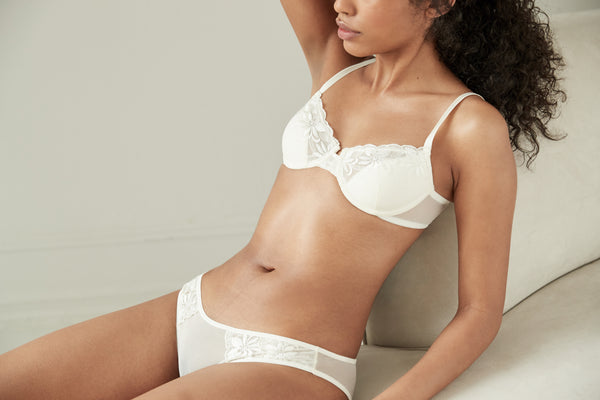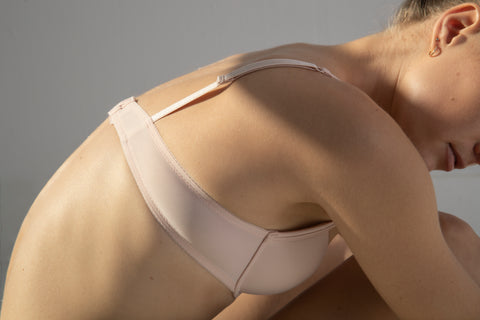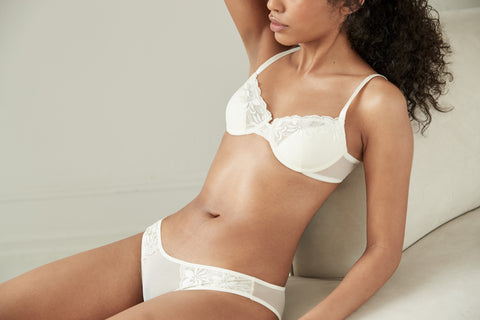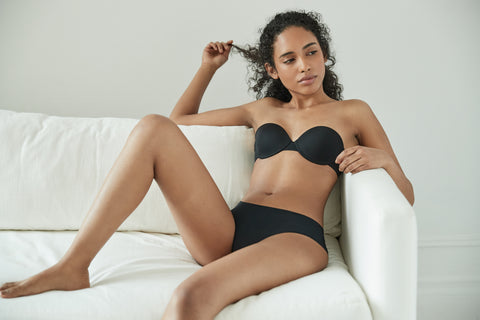Every bra—from a double-G to a triple-A—should fit snugly yet comfortably. It should provide you the support you need without constricting your body. No slipping straps, no red marks after a long day, and absolutely no reason to tear off your bra the moment you walk through your front door.
It’s one thing to say “snugly yet comfortably,” but what does that actually mean?
Small-breasted folks don’t always get the same attention as plus-size shoppers in the lingerie stores but that doesn’t mean your fit is any less important. We’ll cover exactly how A cup bras should fit for everyday comfort.
The Perfect Fit: What To Look For
If you’re looking at yourself in the fitting room or full-length mirror at home and notice these four features, you’ve found an A-cup bra that really, truly fits.
#1 Your Bra Is Fully Supported by the Band
You can check this one by running a quick test: either remove the straps from a convertible bra or simply slip the straps off your shoulders. Did the bra immediately begin to slide? That’s a sign that your band is too big.
You might be thinking, well duh, that makes sense because I’m wearing a bra without its straps. Even if you won’t be wearing this particular bra as a strapless, that doesn’t mean you should be relying on the straps to do the brunt of the work.
A well-fitted A-cup bra should stay up with just the band. If it doesn’t, this is likely a sign that you need to wear your bra on a tighter band setting or go down a band size, but it could also mean your cup size is too large. If your small breasts can’t fully fill out an A-cup, a smaller band size may feel restrictive and even painful without addressing the real problem.
#2 Your Bra Fully Contains Your Breasts
Of course, we’d all probably notice if our breasts were completely popping out of our bras, but the subtle signs of an ill-fitting A-cup might be a bit harder to notice.
If you notice any of the following, your current bra might not be the right fit:
#3 Your Breasts Fully Fill Out Your Cups
The flip side of breast bulging is gaping. Your breasts aren’t overflowing but instead swimming in cups that are way too big—or more likely, just a tad too big in a way that’s not necessarily uncomfortable but isn’t exactly right either.
With a well-fitting A-cup bra, you should notice the following:
- There are no ripples, wrinkles, or dips in the fabric of the cups.
- There’s no extra space at the top of the cups.
- There are no gaps in the cups between your breasts and armpits.
To anyone with large breasts, a cup that’s too big is almost immediately noticeable because it doesn’t provide enough support. But when your breasts are small enough that they don’t desperately need the support of a bra, it can be harder to notice these slight oddities in fit. Still, a properly fitted bra is important for not only aesthetic purposes but also health reasons.
#4 Your Straps Are Snug But Don’t Cut Into Your Shoulders
If you’re used to shopping from a limited selection of petite bras, you might not be familiar with the minute differences in bra sizes. When you have A-cup breasts or even smaller, you might just settle for “tiny” and call it a day.
However, if your A-cup bra is properly supported by a well-fitting band, then the straps shouldn’t be digging into your shoulders. You should be able to fit a finger or two between your shoulder and the strap—no more, no less.
Another sign of too-tight straps is that your bra band looks more like a small peak than a straight, horizontal line across your back. This is because the straps are pulling the band out of its should-be alignment, so keep an eye out for both restrictive straps and a band that doesn’t quite sit right.
Lulalu: Exactly How A-Cup Bras Should Fit
The final piece of the puzzle is purchasing a well-made bra—not just made for anyone, but made specifically for people that share your unique body type. Lulalu’s bras are made exclusively in A, AA, and AAA sizes, meaning we know how to design bras tailored to the proportions of the people who wear them.




